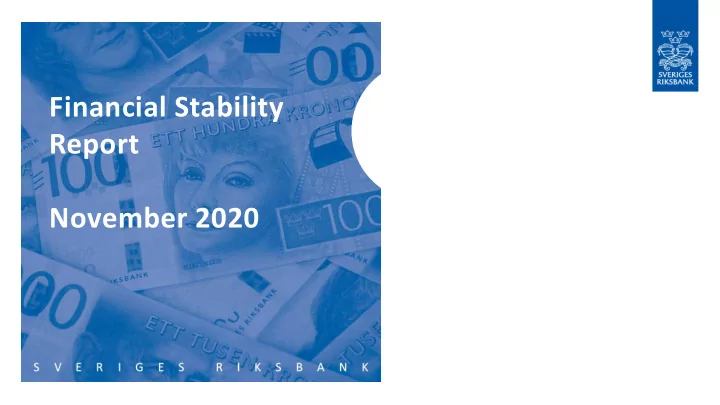

Financial Stability Report November 2020
The implemented support measures have ensured that the financial system has so far coped with the challenges of the coronavirus pandemic relatively well But there is considerable uncertainty and the risks to financial stability are elevated are elevated 2
The coronavirus pandemic has left deep scars, but the recovery is underway Note. Index 2019 Q4 = 100 The chart shows GDP developments in Sweden Sources: Eurostat, Statistics Sweden, and abroad. The broken lines represent the Riksbank’s forecasts from the the US Bureau of Economic Analysis and the Riksbank. Monetary Policy Report in September. Refers to seasonally adjusted data.
Unprecedented support measures have mitigated the effects • Considerable fiscal policy stimulation from governments around the world • Central banks have significantly expanded their balance sheets • Lowering of buffer requirements and temporary easing of regulatory frameworks Note. The chart shows the balance sheets of various central banks as a share of GDP. Source: Macrobond
A combination of measures most effective to support the economy Repo rate 0% Increased access to safe Loans to companies Purchases of interest- and liquid assets via banks bearing securities SEK 500 bn Unlimited SEK, 60 billion USD SEK 500 bn (261 bn) (29 bn, 2 bn) (165 bn) Note. Bold type denotes decided amounts. The figure in brackets refers to utilised amounts.
Lower interest rates and well-functioning credit supply Interest rates have come down Lending has been maintained Note. Left: Per cent. Yields on Swedish bonds with 5-year maturities. The Sources: Macrobond, Statistics Sweden and the Riksbank broken line in both charts represents the date (11 March) when the WHO declared COVID-19 to be a pandemic. The right-hand graph refers to growth in lending to households and companies from MFI. Annual growth in lending.
No clear signs of a credit crunch, but uncertain whether loans reach all companies Lending rates rose to begin with, but have Lending primarily to large companies rose to fallen back begin with Note. Left: Per cent. Refers to interest rates on loans in all currencies. Outstanding Source: Statistics Sweden (KRITA) and the Riksbank. loans. The interest rate refers to the volume-weighted mean. Excluding loans to housing cooperatives. Right: Index, December 2019=100. Refers to lending in all currencies.
Bankruptcies in the corporate sector increased to begin with, but have fallen back • Reduced revenue for many companies during the pandemic • Companies in need of both loans and direct economic support • Many companies that have gone bankrupt during the crisis were in a weak position to begin with Note. Number of bankruptcies for all industries, sizes and forms of incorporation. The broken line represents the monthly average in 2017-2019. Source: Statistics Sweden
Strong price growth on the housing market during the crisis Note. Index, 2015=100. The chart shows housing price growth in Source: Valueguard and the Riksbank Sweden. The prices have been seasonally adjusted.
The challenges of the pandemic have so far been managed, but the road ahead is very uncertain and fraught with risks Risks in the short term • Effects of increased spread of infection and more restrictions • Bankruptcies may increase significantly regardless of the spread of infection • Support measures can be withdrawn too quickly Risks in the longer term • Higher indebtedness for states and companies • Agents always expect to be “saved” • Negative real interest rates and low rates for longer
Vulnerabilities may deepen and prolong the crisis Abroad • Weak banks and public finances Sweden • Low government debt, but high indebtedness among households and companies • Banks have substantial exposure to housing and commercial property • A deeper and more prolonged crisis may lead to banks having trouble maintaining credit supply Note. The chart shows debt in Sweden as a share of GDP. Source: Statistics Sweden
The crisis is not over – important that policy areas cooperate and that buffers are used if necessary Support measures required • Fiscal policy more effective support for adversely affected sectors Banks need to supply credit to companies and households • Capital and liquidity buffers should be used if necessary • Refrain from paying dividends to shareholders until further notice
The pandemic highlights the importance of good resilience in the financial system When the economic situation permits, resilience should be strengthened again. Banks’ buffers should be built up again if they are used. Established regulatory frameworks should be retained and not undermined. Shortcomings on the corporate bond market must be resolved Measures need to mitigate the risks linked to household indebtedness . The exception in the amortisation requirement must remain temporary. Climate-related risks need to remain an important part of the supervision of financial institutions and be integrated into the monitoring of financial stability.
The implemented support measures have ensured that the financial system has so far coped with the challenges of the coronavirus pandemic relatively well But there is considerable uncertainty and the risks to financial stability are elevated are elevated 14
Recommend
More recommend